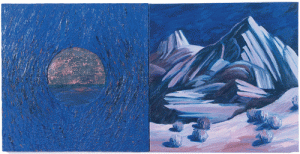
Jessica L. Horton’s “Indigenous Artists Against the Anthropocene” highlights the history of the American Indian Movement (AIM) in relation to the Ecological Movement, then brings attention to present day Indigenous Artists who have persisted through white supremacist and capitalists structures that threaten both the environment and Indigenous communities.
While AIM’s conceptualization of humans living “with the land and not simply on it,” points to a valuable approach to sustainability that recognizes humans’ participation in a larger ecosystem, it is important to avoid stereotyping Indigenous Americans according to the “ecological Indian” trope. Horton writes, “Substituting the ecological Indian for the work of Native thinkers and makers reinforces images of American Indian people as localized reactionaries under perpetual threat from large-scale ruptures such as colonization and climate change, rather than as purveyors of imaginative forms of global collectivity and connectivity.”
Indigenous American oppression is often cast as an object of the past, but like global warming, their struggle is ongoing, part of the past, present, and future. As we fight against climate change, keep in mind the colonial history of resource extraction and exploitation. The same Enlightenment ideals that inspired the industrial revolution, warming our planet, also led to brutal conquest of Indigenous people.
You can read Horton’s full article here: Indigenous Artists against the Anthropocene
Other resources:
From PBS, Native American Communities Affected by Climate Change Plan for the Future

Leave a Reply